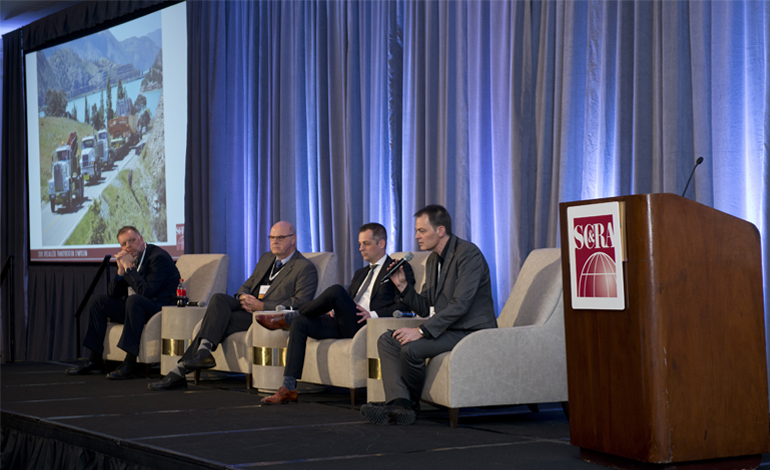By Jonathan Bhana-Thomson, chief executive, NZ Heavy Haulage Association.
Attendance at the Specialized Carriers and Rigging Association’s Transport Symposium in Houston recently by myself enabled new levels of information sharing and common concerns between the two Associations.
It was a huge honour to be invited to be a speaker at the SC&RA’s Specialized Transport Symposium, and it was great to be the opening speaker at the session entitled ‘Perspectives from Global Corridors’.
For many years there have been cooperation between the two association’s including two visits by members of the SC&RA to our country, and this is the second time that I have been invited to speak at an international conference that the SC&RA has been a part of.
The SC&RA is a large international association, but focused primarily on the US, and includes over 1300 members across the specialized transport and crane industries.
The event in Houston recently focused on the oversize and overweight (OS/OW) transport industry, and nearly 600 delegates attended the event. The event included a speaker from New Zealand and, in many ways, we share the same issues. But on other fronts, we are actually ahead of the US and certainly appear to have less levels of regulation to deal with.
A great challenge US transport operators have to deal with is that each State has its own Rule and Permitting process for OS/OW loads, and this is one of the prime advocacy targets that the SC&RA is confronting with its UPT2021 project.
This Uniform Permit Transport initiative is targeted at harmonising OS/OW rules across the country for standard transporter configurations at particular weights – and for these permits to be automatically issued by each State. In this case auto-issued means that the online system will issue them, on application by the operator, without needing any human processing … at 2am in the morning if you wish!
Certainly the experience here in New Zealand is that we are a long way from that. We have only recently moved to online application for permits, and then while there is some computer processing of overweight requirements, the final production of the permits needs human intervention to put the permit together, often with work arounds. Contrast that to the State of Illinois, where weight permits up to 299,999 pounds (just over 136T) are auto-issued.
The one advantage that we do have is that we have a nation-wide State Highway network and permits can be gained for the entire country from the Transport Agency, and it’s just local road permits that are required.
The distance from Invercargill to Kaitaia is around 1900 kilometres and this is just short of the distance from Miami to New York and this route would need permits from eight different States, even travelling on the Interstates.
Our load piloting scheme is almost unique around the world, and delegates at the symposium were very interested to hear about how our completely private pilot scheme works without police escorts. We have had this private scheme for over 20 years and we have a good safety record, in part due to the training and licensing of class 1 (highest grade) of pilots along with the experience and skills that are built up over time as a specialist in the sector.
We also have a range of specific warning lights (purple for over five metres in width) and signage that, as an industry, we have developed and are continuing to develop and evolve to suit the ever-increasing traffic flows on our roads.
We will continue to liaise with the Pilot Car Task Force that has been set up by the SC&RA to promote the use of private pilots and nation-wide industry training and standards. Ontario in Canada has become the first place in North America to replace all police escorts with private pilots at the start of this year.
A great initiative that has been built up by the SC&RA over the years has been the meeting of permit issuing officials from across the different regions of the US at the Symposiums, and this is a great opportunity for industry members to discuss issues and seek greater harmonisation between States within each of the three major groupings.
A nationwide issue confronting the whole trucking industry in the US is the requirement to comply with Electronic Logging Devices (ELDs) that record driving hours by monitoring the engine of a truck. Using this method companies or truck drivers can be monitored to ensure they’re following the hours of service (HOS) law, which mandates how much a driver can work in a day.
In New Zealand we have Worktime regulations and, at present, we still monitor this using paper logs (although there have been trials of e-logbooks).
In the US, there has been a phased approach, but this is becoming a requirement by the end of this year. The US authorities are now looking at allowing some flexibility in the hours of service regulations, as there are many situations that arise in the real world of trucking that make an absolute rule difficult to comply with. However this will be a major compliance issue that trucking companies in the US have to deal with.
Reflecting on the event, it is clear that we do share many of the same issues. With some of these we are further down the track in developing solutions that suit our industry.
With other issues we have a long way to go.
However, the warm welcome I received, and the reception that I got, showed that we are all part of one big trucking fraternity.


Parting words from Jeremy Sole- a final column